Apple's Redesigned MacBook and MacBook Pro: Thoroughly Reviewed
by Anand Lal Shimpi on October 22, 2008 12:00 AM EST- Posted in
- Mac
Several years ago I was privy to a conversation that didn't make much sense to me. The topic was whether or not PCs could be sold like cars, by model year instead of focusing on specs. The holy grail of PC sales has always been distilling the myriad of system specifications down to a simple, easy to understand number. Intel used to offer its iCOMP rating for microprocessors on PCs sold in stores, benchmarks like 3DMark have attempted to do the same thing as well. It'd be far easier however if consumers simply purchased based on model year; buying a 2008 model year PC would be better and faster than a 2007. The idea obviously didn't go anywhere and it didn't make a whole lot of sense to me given that, unlike cars, computers are generally not as emotional of a purchase.
I think Apple has managed to change that. Nearly every year or so we get a redesigned Mac, iMac or MacBook, and in many cases while they are no faster than their predecessor - they introduce one or two new features or a new design that makes you want them, with all logic cast aside. It's a lot like buying a car.
Apple sells its computers not only based on functionality, but largely based on the form and design. Now all manufacturers do this to an extent, it's just that none of the mainstream PC OEMs do it as much or as well as Apple. Apple's focus on design makes a lot of sense. All PCs can be created equal, these days Apple and Dell use the same components, so the only differences that Apple has to play with are the OS and the design. Thus investing more money into the OS and system design is the right move for a company like Apple.
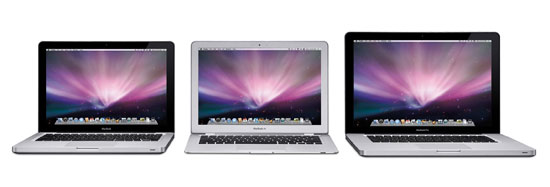
The MacBook, MacBook Air and MacBook Pro
Last week Apple announced its updated MacBook, MacBook Air and MacBook Pro lineup. As expected the changes were largely aesthetic and the new machines look great. But there were also some pretty significant departures under the hood, thus giving me something to do here other than comment on how the curved corners are nice to pet. There are benchmarks to be run, battery life to be tested and something very unexpected to uncover about OS X vs. Vista at the end. I won't dilly dally for too long here, so let's get right to it.
Design Changes/Build Quality
It turns out that all of the extra money Apple is spending on its notebooks goes into materials and build quality. It looks like there are two areas where that money is used: the aluminum chassis and the glass display cover.
The MacBook and MacBook Pro are now made like the MacBook Air: carved out of a single piece of aluminum. That's actually a bit misleading, there are multiple pieces of aluminum that go into the construction of these things, but looking at the keyboard from above you see a single block of aluminum that has been shaped to look like a MacBook.
The PowerBook G4 and the first MacBooks had the keyboard built into a piece of aluminum that sat on top and there was another piece of aluminum that made up the bottom half of the notebook. The two screwed/snapped together and what you had was an aluminum notebook.
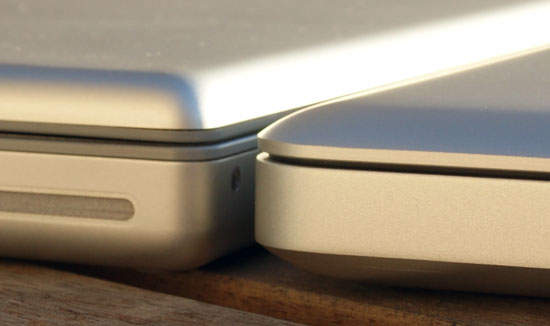
The old MacBook Pro (left) vs. the new MacBook Pro (right), note how the old MBP doesn't fit together nearly as well as the new one
With the new MacBook/MacBook Pro, Apple has effectively flipped its manufacturing process upside down. Instead of having a bottom that curves upwards and is capped off with a keyboard, the new models have a top that curves downwards with two plates that cover the bottom. The distinction is subtle but the difference is noticeable.
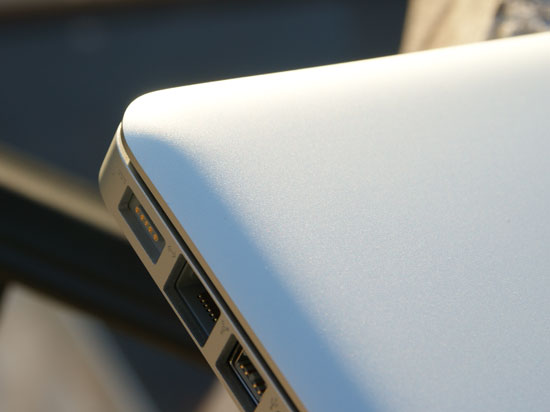
Rounded corners, it's like a big MacBook Air. Cute.
Rigidity is one of the biggest factors in making a notebook feel like it's well built. This is one of the things that IBM got very right with its Thinkpads early on, and something that Apple honestly did an incredible job with on the MacBook Air. The problem with building light notebooks is that the lighter you go, the flimsier the materials and the worse they hold up over time. By making sure the part you come in contact with the most is made out of a single piece of aluminum, Apple helps convey a sturdier built product.
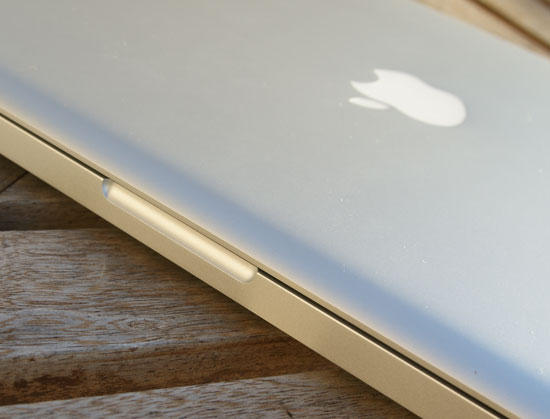
Look ma, no latches!
Also gone is the bothersome latch from the MacBook Pro, the screen magnetically attaches to the keyboard surface when you close it. The latch on the old MBP was the cheapest feeling part of the machine, so I'm glad they fixed it.
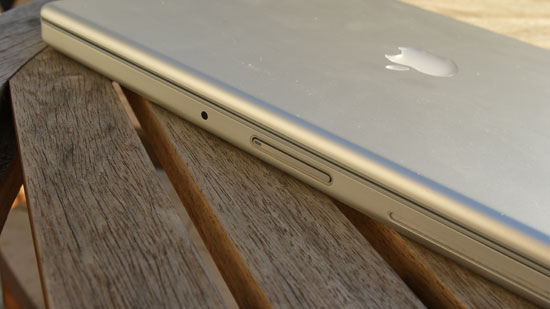
The old latch, ugh.
Apple also made it easier to access the hard drive on these things, there's a nifty removable panel underneath the notebook that unlatches without a single screw. With the cover removed you can replace the battery or, after removing a single screw, remove the hard drive (you'll need to take out four more screws to actually swap out the drive though). This isn't quite as easy as the removable HDD trays you'd find in a Dell, but it does look better.
The design is far from perfect however, the new battery/HDD cover tends to rattle and definitely reduces the solid feeling of the notebook. Thankfully the parts of the notebook you interact with the most feel the most solid, it's just worth pointing out the imperfections.










66 Comments
View All Comments
plonk420 - Thursday, October 23, 2008 - link
could anyone test this with the new (and even old) Mac Book Pro to test for CPU usage?http://www.megaupload.com/?d=ADFYX083">http://www.megaupload.com/?d=ADFYX083
h.264 high profile (QT supports this now, right?) level 4.1 720p60, fairlight/the black lotus's demo Only One Wish (2nd place at Intel's second demo compo) .. has some really handsome bitrate spikes :D ~mid 20s mbps spikes (but not as good as the 60mbit spikes in a 6 or 8mbit (average) encode of ASD's Antisize Matters)
michaelheath - Thursday, October 23, 2008 - link
Having spoken to a few Apple developers I know, the reason for this oddity is Nvidia's software implementation for Mac OS 10.5. While the ideal situation was for them to be able to switch on the fly, the agreement between Apple and Nvidia to develop for the new MacBooks and MacBook Pros happened so quickly it left little time to create a proper application that would allow for this (think of how you had to restart your computer to turn SLI on or off: same slapdash type of programming).The hope is that quick-toggling between integrated and dedicated graphics will come with Mac OS 10.6 as it may be too large of an update to patch Mac OS 10.5. It also makes sense in this aspect as Mac OS 10.6 also includes OpenCL GPGPU algorithms, which Nvidia is already promoting and developing under their CUDA platform.
RDO CA - Thursday, October 23, 2008 - link
On my Thinkpad T-400 with switchable graphics all that is needed to switch is to go to the taskbar icon and click switchable graphics and choose what you want and the screen goes dark for a second and thats it.cliffa3 - Thursday, October 23, 2008 - link
I'll test it sometime this week, but on my Lenovo T61 it seems like I get much more life out of Ubuntu than I do Vista 64-bit. Could be a windows thing in general, not just something that OS X does better.How was the battery life comparison between XP and Vista?
PilgrimShadow - Thursday, October 23, 2008 - link
Anyone know if the 9400M and 9600M appear in Vista's Device Manager?TallCoolOne - Thursday, October 23, 2008 - link
I bought the new 2.0GHz MacBook last week as my first Mac and can say I'm not disappointed. The whole chassis feels as solid as, well, a block of aluminum! As Anand said, it feels like you get what you paid for. I actually like the multi-touch gestures, such as swiping with 3 fingers to flip pages and for back/forward when web browsing. I'd like to see iTunes also support that gesture. Two finger scolling is another great feature not mentioned in this article. What I don't like though is the stiffness of the mouse click. It takes far more pressure than any mouse and that required pressure is uneven in different areas of the trackpad. Pressing near the top requires more pressure than near the bottom. As for lack of standard SSD, Anand, perhaps you're a little too spoiled by that speed! I would not expect that as standard on even the fastest MacBook Pro at current prices. That is, unless you'd like to see the asking price for a MBP $500-600 more than it is now.vlado08 - Thursday, October 23, 2008 - link
It is interesting was vista side panel running during the test. Also was this fresh install of vista os. If it was fresh then was the indeing enabled.vlado08 - Thursday, October 23, 2008 - link
edit indeing - indexingjmpt2 - Thursday, October 23, 2008 - link
Very interesting to read your conclusions about better power management in MacOS vs Vista. This matches my experiences running Vista on the BootCamp partition of my Core Duo MacBook, and is the first time I've seen this discussed anywhere on the web. I found that with a main battery in quite poor condition after two years constant use, it became impossible to use Vista on battery power for more than a minute without the battery deciding it was empty and putting the machine into sleep mode. Under MacOSX the system could still be used for 30min+ (light use) before the same thing happened.I'd come to the conclusion that Apple were deliberately playing games with the ACPI tables to confuse Vista's power management code and make their own OS look better. This seemed to be supported by the fact that Vista is unable to correctly detect the charging state on my MacBook - running on battery power it would always report "Connected to mains, not charging". Does it still work that way on the latest MacBooks? In any case, your data does seems to suggest the problem is a more general issue with Vista. Sounds like you should investigate further...
BZDTemp - Thursday, October 23, 2008 - link
I wonder if OS X lasting longer on a battery can be transfered to the world of none portable?In other words say I run OS X on my daily, none laptop, work machine doing surfing, writing and perhaps listening to music(FLAC prefered over MP3) or even watching an episode of The Daily Show. Will this draw less power from the wall with a PC running OS X than with the same machine running Windows (and is there a difference between Windows versions). Also Linux should be included in the test.
Imagine the perspective - with the whole green computing movement this could really make a difference not just in the server rooms.
Please do check this out - this is not only interesting for us geeks but could make Anandtech something referred to by none-tech news media.